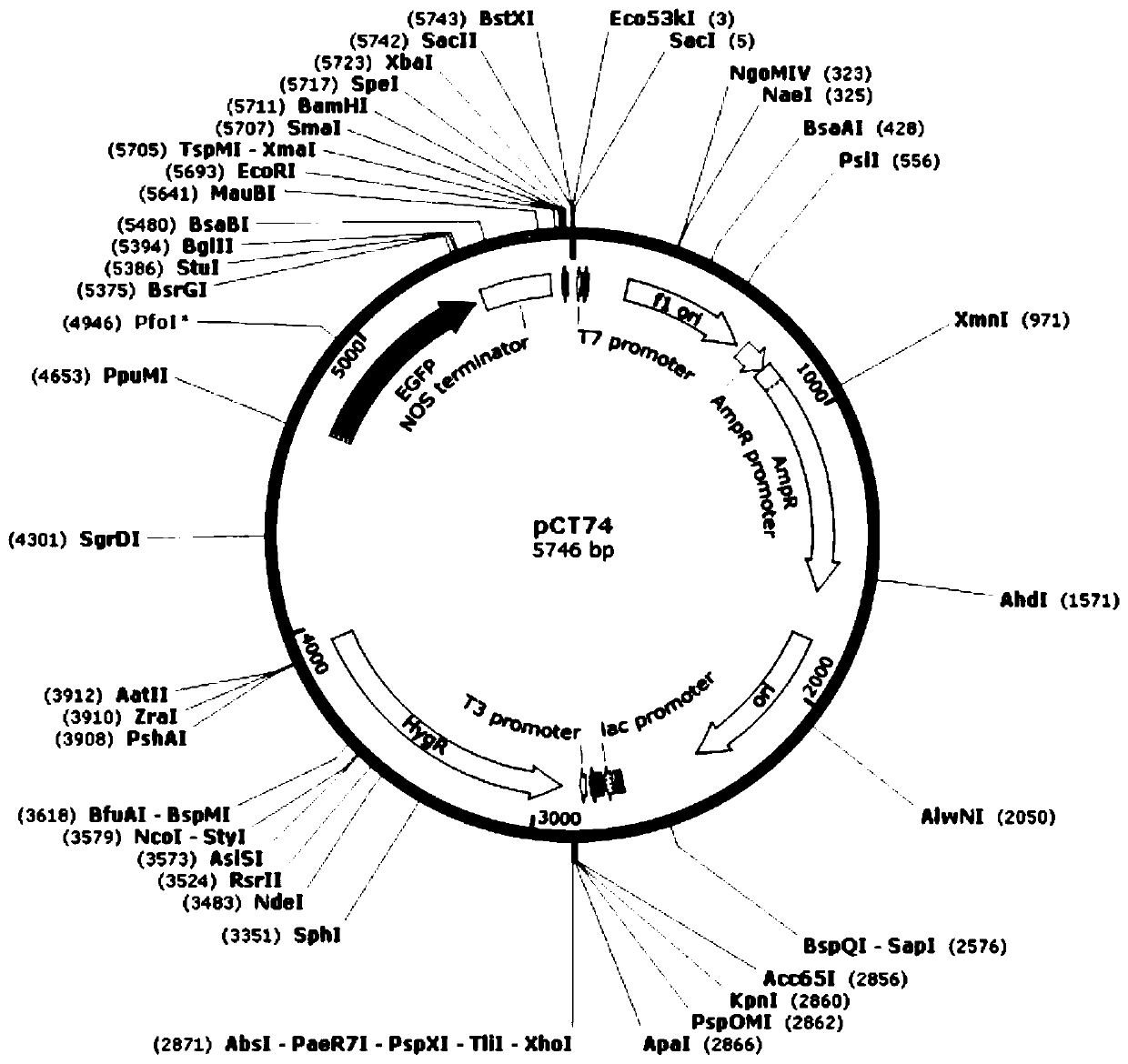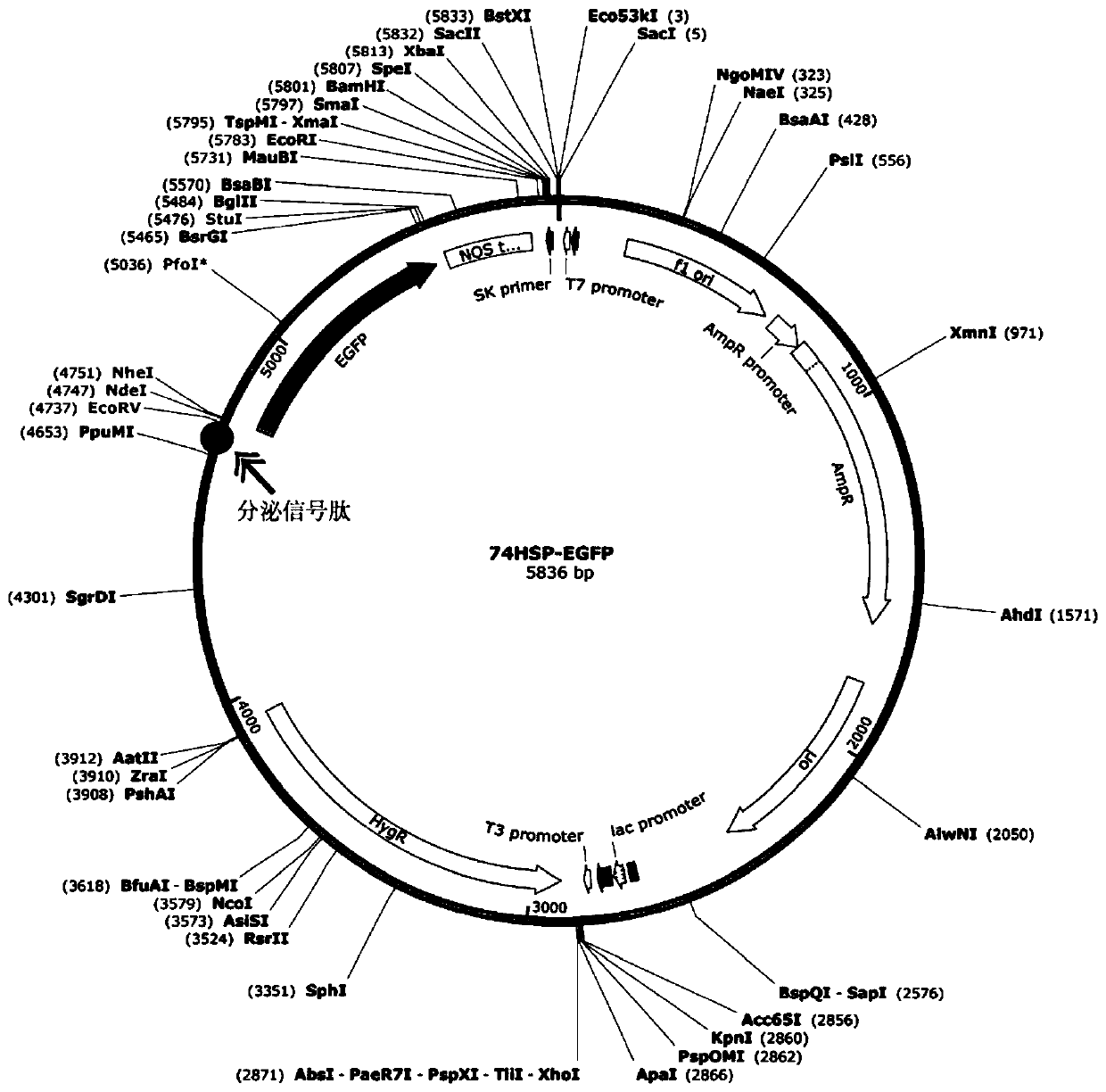Fungus secretory expression vector as well as construction method and application thereof
A technology for secretion expression and expression vectors, which is applied in the field of fungal secretion expression vectors, which can solve the problems of target protein residues, inability to effectively cut and secrete proteins, and difficult development, etc., and achieve the effect of rapid identification
- Summary
- Abstract
- Description
- Claims
- Application Information
AI Technical Summary
Problems solved by technology
Method used
Image
Examples
Embodiment 1
[0036] Example 1 - Determination of extracellular signal peptide and design of a short sequence comprising an enzyme cleavage site
[0037] 1. The present invention identifies a highly abundant secreted protein Six1d from Fusarium oxysporum Cuban specialization type No. 1 race (Foc1) through secretome proteomics, and predicts the protein sequence N through signal peptide analysis There is a 21aa extracellular signal peptide at the end, protein cleavage and secretion can be achieved between 21aa and 22aa, and the 23aa or even 30aa at the N-terminus cannot be predicted to be effectively cleaved when used alone, although the protein N-terminal 40aa and The 50aa sequence can realize protein cleavage and secretion, but when the vector constructed with the 40aa or 50aa sequence is used, a longer sequence will be left at the N-terminal of the target protein, which will affect the function of the target protein.
[0038] 2. The specific experiment is as follows:
[0039] (1) Using th...
Embodiment 2
[0054] Embodiment 2-a method for constructing a fungal secretion expression vector, comprising the steps of:
[0055] (1) Through signal peptide analysis, it was determined that the secretory signal peptide sequence was the extracellular signal peptide of Six1d protein N-terminal 23aa (MAPYSMVLLGALSILGFGAYAQE), and the nucleotide sequence was: ATGGCGCCCTATAGCATGGTACTCCTTGGCGCCCCTCTCAATCCTTGGGTTTGGGGCTT ATGCTCAAGAG; and designed a short sequence of the enzyme cleavage site, nucleotide sequence It is: GATATCCATATGGCTAGCAGGCCT; the short sequence of the enzyme cutting site includes four restriction enzyme sites of EcoRV, NdeI, NheI and StuI;
[0056] (2) Use a nucleic acid synthesizer to synthesize a vector sequence comprising a signal peptide and a short sequence of restriction sites;
[0057] (3) The vector sequence containing the signal peptide and the short sequence of the restriction site was connected to the pCT74 vector by T4-DNA ligase to obtain the fungal secretory expre...
Embodiment 3
[0058] Embodiment 3 - a method for constructing a fungal secretion and expression exogenous gene system, comprising the following steps:
[0059] (1) Connect the exogenous EGFP gene into the fungal secretory expression vector 74HSP through NheI and StuI restriction enzymes in the short sequence of the restriction site to obtain a complete 74HSP-EGFP recombinant vector;
[0060] (2) The 74HSP-EGFP recombinant vector was transformed into Fusarium oxysporum Foc4 to obtain the FOC 4 transformant transformed with the pCT74-S secretory vector.
PUM
 Login to View More
Login to View More Abstract
Description
Claims
Application Information
 Login to View More
Login to View More - R&D
- Intellectual Property
- Life Sciences
- Materials
- Tech Scout
- Unparalleled Data Quality
- Higher Quality Content
- 60% Fewer Hallucinations
Browse by: Latest US Patents, China's latest patents, Technical Efficacy Thesaurus, Application Domain, Technology Topic, Popular Technical Reports.
© 2025 PatSnap. All rights reserved.Legal|Privacy policy|Modern Slavery Act Transparency Statement|Sitemap|About US| Contact US: help@patsnap.com



